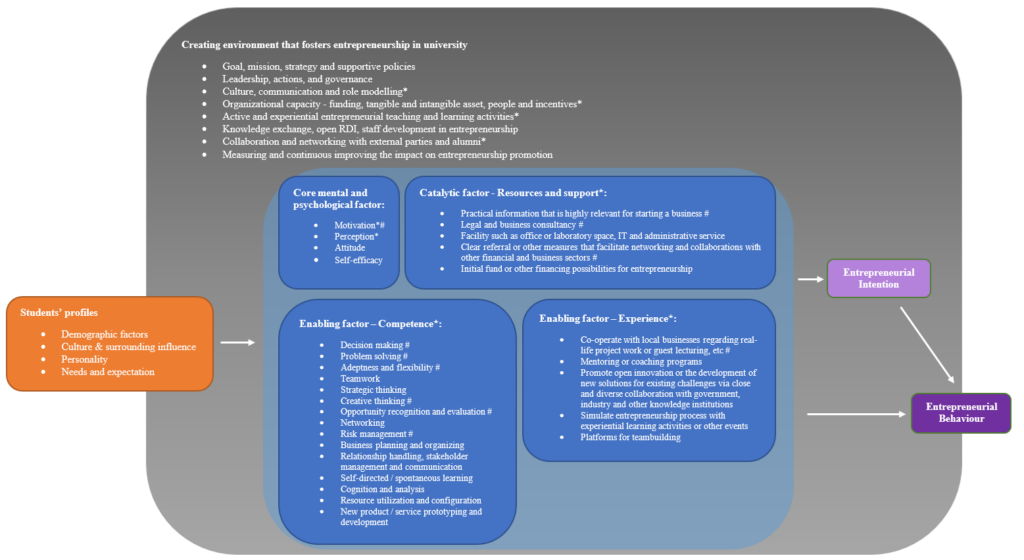How to effectively foster entrepreneurship in VAMK?
Entrepreneurship is a dynamic topic that evolves through time and an important phenomenon to both society and economy, hence it is understandable that there has always been a demand for more and the next generation of entrepreneurs. Beyond teaching and research, what could be the better and more suitable way to fulfill the 3rd missions of universities – to facilitate economic and social development? The answer is to foster entrepreneurship on campus – to increase the supply of future entrepreneurs and individuals with entrepreneurial competence. You never know that some day when the time comes, some student(s) might just start a business that could generate jobs and income. On the other hand, since entrepreneurship is learnable and students are a promising source of future entrepreneurs, it is almost mandatory for universities to educate potential student entrepreneurs or guide the students towards entrepreneurship as a career option in order to stay competitive nowadays. But how?
Recently a quantitative research was done aiming to explore the current situation of fostering entrepreneurship in VAMK from the students’ perspectives and seek for improvement. It has not only identified a set of influenceable factors that could foster entrepreneurship among the students, but also provided a practical and customized model for VAMK.
Based on the model (Figure 1) provided by the research, there are four factors that foster students’ entrepreneurial intention and behavior – one core factor, two enabling factors and one catalytic factor. The core factor is mentally and psychologically related to entrepreneurship and has a fundamental influence on one’s decision to become an entrepreneur or not. The two enabling factors – students’ entrepreneurial competence and experience – will not only ensure that one knows how to perform actual entrepreneurial tasks, but also increase the probability of success and enhance one’s entrepreneurial intention. Last but not least, the catalytic factor referring to resources and support provided by VAMK will not only advance the emergence of students’ entrepreneurial behavior during their time in the university or soon after graduation, but also accelerate and protect their initial entrepreneurial processes, lowering the probability of failure in the new venture’s early stage. All the four factors have own listed elements sorted by descending importance from the students’ perspectives.

In addition, students’ profiles are taken into consideration in this model, which include four elements – demographic characteristics, culture and surrounding influence, personalities, as well as needs and expectation towards entrepreneurship. The students’ profiles are having an effect on the four factors, because different profiles will require different combinations of stimulations on the factors, and hence they determine how VAMK should interact with these factors to optimize the effect on fostering entrepreneurship.
Furthermore, all the four factors can be influenced positively as well as enhanced in an entrepreneurship-fostering environment, which can be achieved by configuring and realizing eight areas in VAMK:
- Establish a clear and proper goal, mission, strategy and supportive policies
- Adopt effective leadership, actions, and governance
- Create an entrepreneurial culture, communicate and role model to advocate and encourage entrepreneurship
- Build and utilize organizational capacity – funding, tangible and intangible asset, people and incentives
- Design and apply active and experiential entrepreneurial teaching and learning activities
- Promote knowledge exchange and open RDI with other institutes, support staff development in entrepreneurship
- Collaborate and network with external parties and alumni on projects, events, pro-grams and lectures
- Measure and continuously improve the impact on entrepreneurship promotion
Finally, the output of this model is students’ actual entrepreneurial behavior, which could appear either inside or outside VAMK’s environment during their study time, or after their graduations.
The most important function of this model is to provide VAMK a practical framework of how to effectively foster entrepreneurship by working on the four factors and eight areas properly. Based on the result of the research, VAMK’s general performance in fostering entrepreneurship seems to be on midlevel from the students’ points of view and there are significant gaps between students’ expectation and the reality in certain areas. However, three items in the model, including goal/mission/strategy/supportive policies, leadership/actions/governance, and measuring and continuously improving the impact on entrepreneurship promotion, were not in this research’s range because the students could not provide proper evaluations on these items from their perspectives. Nevertheless, the model has shown that the items with an asterisk (*) are the areas that will need improvement as they are rated significantly lower than the students’ expectation, and the items with a hash sign (#) are the focus areas that will require extra substantial effort to develop.
Last but not least, there are other interesting and important findings from the research. First, entrepreneurial competence is observed to be more important than the other three factors. Second, regarding building entrepreneurial competence, female students might need more support. Third, opportunities to obtain entrepreneurial experience should be equally provided to all students in VAMK, e.g., students from the school of health care and social services. Fourth, it would be an effective and resource-optimized practice to identify the entrepreneurship-intending students (usually the students with strong entrepreneurial personality) and offer them special educational programs as well as resource and support on need base, because they are more serious about building their entrepreneurial competence and experience, and they also value and require resource and support whenever they could start their own businesses for real.
Together, for a good start of a promising reform into an even more competitive higher educational institute, the model and the findings from this research have provided VAMK with detailed, customized and practical information on how to effectively foster entrepreneurship on campus, the rest of the story is then up to the commitment, actions and efforts from both the leadership and the staff of VAMK. For further knowledge, please refer to the thesis of the research – ‘FOSTERING ENTREPRENEURSHIP ON CAMPUS – CASE VAMK’ (Author: Jianyu Ou).




